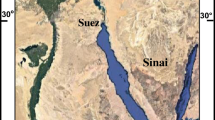Abstract
Coral samples were collected from Kurusadi, Shingle and Appa islands of Gulf of Mannar for analyzing the trace elements. The mean concentrations in the coral reef skeleton ranges from 0.19 to 0.62 μg g−1 for Fe, from 6.71 to 15.6 μg g−1 for As, from 0.28 to 1.31 μg g−1 for Cd, from 0.56 to 5.29 μg g−1 for Co, from 7.25 to 22.34 μg g−1 for Cr, from 0.63 to 5.08 μg g−1 for Cu, from 98.38 to 138 μg g−1 for Mn, from 0.18 to 2.53 μg g−1 for Ni, from 0.18 to 4.56 μg g−1 for Pb and from 44 to 135.25 μg g−1 for Zn. The factor analysis revealed the source of trace elements accumulation in the coral skeleton particularly Mn from detrital inputs and Cd from anthropogenic sources. This paper also highlights the nature of trace elements available in coral skeleton.


Similar content being viewed by others
References
Anu Gopinath, Nair SM, Kumar NC, Jayalakshmi KV, Padmalal D (2009) A base line study of trace metals in a coral reef sedimentary environment, Lakshadweep Archipelago. Environ Earth Sci. doi:10.1007/s12665-009-0113-6
Bastidas C, Garcia E (1999) Metal content on the reef coral Porites asteroids: an evaluation of river influence and 35 years of chronology. Mar poll Bull 38:899–907
Beyersmann D (1994) Interactions in metal carcinogenicity. Toxicol Lett 72:333–338
Brown BE (1987) Heavy metal pollution on coral reefs. In: Salvat B (ed) Human impact on coral reef: facts and recommendations. Antenne Museum EPHE, French Polynesia, pp 119–134
Brown BE, Howard LS (1985) Assessing the effects of ‘‘stress’’ on reef corals. In: Blaxter JHS, Yonge M (eds) Advances in marine biology. Academic Press, Toronto, p 63
Esslemont G (2000) Development and comparison of methods for measuring heavy metal concentration in coral tissues. Mar Chem 69:69–74
Goncalves GO (1993) Instrucao Tecnica, IT 003. Biblioteca CETEM, Rio de Janeiro, p P6
Guzman H, Jimenez C (1992) Contamination of coral reefs by heavy metals along the Caribbean Coast of Central America. Mar Poll Bull 24:554–561
Howard LS, Brown BE (1984) Heavy metals and reef corals. Oceanogr Mar Biol Ann Rev 22:195–210
Inoue M, Suzuki A, Nohara M, Kan H, Edward A, Kawahata H (2004) Coral skeletal tin and copper concentrations at Pohnpei, Micronesia: possible index for marine pollution by toxic anti-biofouling paints. Environ Poll 129:399–407
Khaled A, El Nemr A, El Sikaily A (2003) Contamination of coral reef by heavy metals along the Egyptian Red Sea Coast. Bull Environ Contam Toxicol 71:577–584
Linn LJ, Delaney ML, Druffel ERM (1990) Trace metal in contemporary and seventeenth century Galapagos records of seasonal and annual variations. Geochim Cosmochim Acta 54:387–393
Loring DH, Rantala RTT (1992) Manual for geochemical analyses of marine sediments and suspended particulate matter. Earth Sci Rev 32:235–283
Negri AP, Heyward AJ (2001) Inhibition of coral fertilisation and larval metamorphosis by tributyltin and copper. Mar Environ Res 51:17–27
Peters EC, Gassman NJ, Firman JC, Richmond RH, Power EA (1997) Ecotoxicology of tropical marine ecosystems. Environ Toxicol Chem 16(1):12–40
Reichelt AJ, Jones GB (1994) Trace metal as tracers of dredging activity in Cleveland Bay—field and laboratory studies. Aust J Mar Freshwater Res 45:1237–1250
Reichelt-Brushett AJ, Harrison PL (2004) Development of a sublethal test to determine the effects of copper and lead on scleractinian coral larvae. Arc Environ Contam Toxicol 47:40–55
Salomons W, Forstner U (1984) Metals in the hydrocycle. Springer, New York, p 349
Shen GT, Boyle EA (1987) Lead in corals: reconstruction of historical industrial fluxes to the surface ocean. Earth Planet Sci Lett 82:289–304
Yosumura S, Vartsky D, Ellis KJ, Cohn SH (1980) Cadmium in human beings: cadmium in the environment. In: Nriagu JO (ed) Partz ecological cycling. Wiley, NewYork, pp 12–34
Acknowledgments
The authors are thankful to the Dr. M. Prithviraj, Director, Earth System Sciences, Department of Science and Technology, New Delhi for providing financial support (Grant No. SR/S4/ES-44/2003, dated: 01/11/2004) and also thank the authorities of Manonmaniam Sundaranar University, Tirunelveli and Cochin University of Science and Technology, Kochi for providing necessary facilities to carry out this work.
Author information
Authors and Affiliations
Corresponding author
Rights and permissions
About this article
Cite this article
Krishna Kumar, S., Chandrasekar, N. & Seralathan, P. Trace Elements Contamination in Coral Reef Skeleton, Gulf of Mannar, India. Bull Environ Contam Toxicol 84, 141–146 (2010). https://doi.org/10.1007/s00128-009-9905-3
Received:
Accepted:
Published:
Issue Date:
DOI: https://doi.org/10.1007/s00128-009-9905-3




